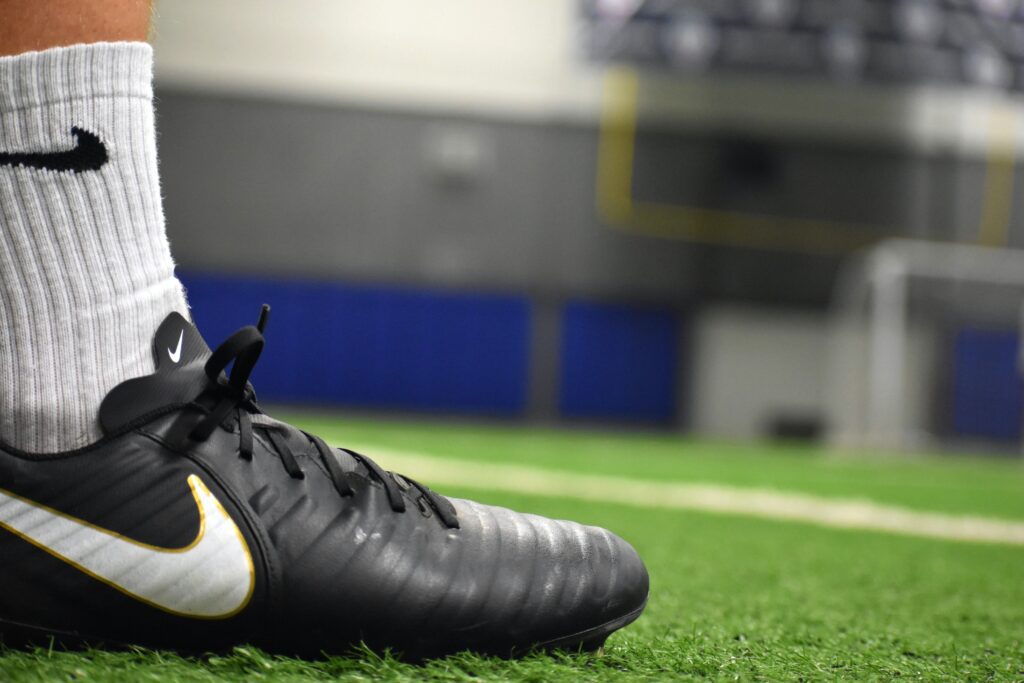5 Ways to Extend the Lifespan of Your Soccer Cleats
As a soccer player, your cleats are one of the most important tools in your arsenal. They provide the grip and support you need to make quick moves and outmaneuver your opponents on the field. But without proper care, your cleats can wear out quickly and will become less effective. This eventually costs you both money and performance.
Once you learn how to choose soccer cleats, it is important for you to understand how you can take care of the soccer cleats that you’ve bought.
Fortunately for you, there are simple steps you can take to extend the lifespan of your soccer cleats and keep them in top condition. In this article, we’ll discuss five easy ways to care for your cleats, from cleaning and drying to wearing them properly. With these tips, you can ensure that your cleats last as long as possible and help you perform your best on the field.

Tip #1: Clean your cleats after each use
After a game or practice session, your cleats are likely to be covered in dirt, mud, and grass stains. Leaving them dirty can cause the buildup of debris, which can impact the performance of your cleats and even lead to damage over time. To keep your cleats in top condition, it’s important to clean them thoroughly after each use.
The first step is to remove any loose dirt and debris with a brush or dry cloth. Then, you can use a damp cloth or sponge to wipe down the surface of your cleats, paying special attention to the seams and crevices where dirt can accumulate. If there are stubborn stains or grime, you can use a specialized cleaning product designed for sports shoes, but make sure to follow the manufacturer’s instructions carefully.
After cleaning, allow your cleats to air-dry completely before putting them away. However, make sure to avoid using heat sources such as a hair dryer or putting them in direct sunlight. Doing so can damage the materials and cause the cleat to lose its shape gradually.
Therefore, by cleaning your cleats after each use, you can ensure that they stay in top condition for a longer time.
Tip #2: Allow your cleats to dry properly
After cleaning your cleats, it’s important to ensure they dry properly before storing them. Dampness and moisture can damage the materials and cause unpleasant odors to develop. This is a major reason why soccer cleats stink. To keep your cleats fresh and fit, here are some tips for drying them properly:
- Remove any excess water or moisture with a dry towel or cloth.
- Stuff your cleats with newspaper or paper towels to help them retain their shape and absorb moisture.
- Leave your cleats in a cool, dry place with good ventilation, ideally near an open window or a fan.
- If you need to use your cleats again soon and they’re not completely dry, you can use a boot dryer or a gentle heat source like a low setting on a hairdryer to speed up the process.
Avoid leaving your cleats in a confined space, such as a plastic bag or a locker, as this can trap moisture and cause mildew or bacteria to grow. By allowing your cleats to dry properly, you can prevent damage and unpleasant odors, and ensure that they are ready for your next game or practice session.
Tip #3: Alternate between two pairs of cleats
Using the same pair of cleats for every game and practice can lead to faster wear and tear, as well as the buildup of odors and bacteria. One way to extend the lifespan of your cleats is to alternate between two pairs.
By switching between two pairs of cleats, you can give each pair time to rest and recover between uses, allowing them to dry out fully and regain their shape. This can also help prevent injuries, as your feet may be more prone to blisters and other issues if you wear the same pair of cleats too often.
Ideally, you should invest in two pairs of cleats that are similar in style and fit, so that you can switch between them easily. Make sure to label or mark your cleats so that you can keep track of which pair you wore last. Then you can easily rotate them regularly to ensure that you wear them evenly.
Remember that even with proper care, cleats will eventually need to be replaced. As a general rule, you should replace your cleats at least once a year if you use them frequently, or sooner if you notice signs of damage or wear. By alternating between two pairs of cleats, you can help extend their lifespan and get the most out of your investment.
Tip #4: Store your cleats properly
How you store your cleats can also affect their lifespan. To prevent damage and ensure they stay in good condition, here are some tips for storing your cleats:
- Store your cleats in a cool, dry place away from direct sunlight, heat sources, and dampness.
- Avoid storing your cleats in a tightly sealed container or plastic bag, as this can trap moisture and cause mildew or odors.
- Consider using a cleat bag or a mesh bag to store your cleats, as this can provide ventilation and prevent them from rubbing against other objects.
- Keep your cleats in a separate compartment or area of your sports bag to prevent them from getting crushed or damaged by other items.
By storing your cleats properly, you can help prevent damage and ensure that they stay in good condition for longer. This can save you money in the long run and help you perform your best on the field.
Tip #5: Regularly inspect your cleats for signs of wear and tear
Finally, it’s important to regularly inspect your cleats for signs of wear and tear. Over time, even with proper care and maintenance, your cleats will eventually show signs of damage and wear. Here are some things to look out for:
- Cracks or tears in the upper material or sole
- Loose or missing studs
- Worn-out laces or eyelets
- Deformed or misshapen cleats
If you notice any of these signs, it’s time to replace your cleats. Continuing to use damaged or worn-out cleats can lead to discomfort, injuries, and decreased performance on the field.
By regularly inspecting your cleats and replacing them when necessary, you can ensure that you always have a reliable and comfortable pair of cleats to wear for your games and practices. This can also help you avoid injuries and perform at your best on the field.
Final Thoughts
Soccer cleats are an essential piece of equipment for any soccer player, and investing in a good pair can make all the difference in your performance on the field. By following these five easy tips for extending the lifespan of your cleats, you can ensure that you get the most out of your investment and perform at your best for longer.
Remember to always clean and dry your cleats properly after each use, alternate between two pairs to allow them to rest and recover, store them in a cool and dry place, and regularly inspect them for signs of wear and tear. By taking care of your cleats, you can not only extend their lifespan but also ensure that you are comfortable and safe while playing.
And finally, remember that while it’s important to take care of your soccer cleats, they will eventually need to be replaced. So be sure to keep an eye out for signs of damage and wear and replace them when necessary.
With these tips, you can ensure that your soccer cleats stay in top condition and continue to serve you well on the field. Good luck, and happy playing! If you like what you’ve read, make sure to read our articles on how to break in soccer cleats and how to clean them.
Frequently Asked Questions (FAQs)
1. How do you keep cleats fresh?
To keep your soccer cleats fresh, make sure to clean and dry them properly after each use. Use a soft brush to remove dirt and debris, and let them air dry in a well-ventilated area. You can also use a shoe deodorizer or place dryer sheets inside your cleats to keep them smelling fresh.
2. What is the lifespan of soccer cleats?
The lifespan of soccer cleats varies depending on factors such as usage, care, and quality. On average, a good pair of soccer cleats can last for six months to a year with proper care and maintenance.
3. Do expensive cleats last longer?
A: Not necessarily. While expensive cleats are often made of higher-quality materials and may offer better performance features, their lifespan still depends on how well they are cared for and maintained.
4. Does putting cleats in hot water help?
No, putting cleats in hot water can actually damage them. The high heat can cause the glue to weaken and the materials to warp or shrink, which can lead to discomfort and decreased performance.
5. How fast do cleats wear out?
Cleats wear out at different rates depending on how often they are used, the type of surface they are used on, and how well they are cared for. On average, a good pair of soccer cleats can last for six months to a year with proper care and maintenance.







